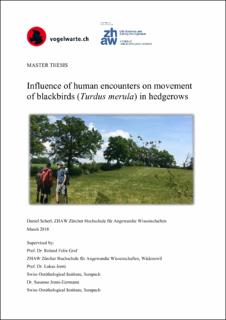Please use this identifier to cite or link to this item:
https://doi.org/10.21256/zhaw-20663Full metadata record
| DC Field | Value | Language |
|---|---|---|
| dc.contributor.advisor | Graf, Roland Felix | - |
| dc.contributor.advisor | Jenni, Lukas | - |
| dc.contributor.advisor | Jenni-Eiermann, Susanne | - |
| dc.contributor.author | Scherl, Daniel | - |
| dc.date.accessioned | 2020-10-22T10:21:24Z | - |
| dc.date.available | 2020-10-22T10:21:24Z | - |
| dc.date.issued | 2018 | - |
| dc.identifier.uri | https://digitalcollection.zhaw.ch/handle/11475/20663 | - |
| dc.description.abstract | Outdoor recreation is increasing in intensity and space. Areas previously inaccessible are now being visited by ever-growing numbers of people, which increases human-wildlife encounters across taxa. Animals often perceive humans as predators and mount physiological and behavioural responses that can have negative consequences. Human disturbances, even at low levels, are likely to impact species during sensitive breeding season in a sex- and status-specific way. However, experimental studies on movement behaviour for the same individual during consecutive days are lacking. Here, we experimentally disturbed blackbirds in hedgerows over several days and quantified their flying distances and movement events using radio-telemetry. We compared the movement before, during and after a disturbance using linear mixed effects models (LME). We showed that Blackbirds of unknown status increased their flying distances during disturbance to the non-disturbed periods directly before and after (+95.5 m/10min / +114 m/10min) and showed a strong tendency to increase numbers of movement events. Contrary to our expectations, we did not find a clear long lasting effect despite the trend that females with unknown status remained at the same flying distances as during disturbance. For feeding blackbirds we found a sex-specific tendency that females reduced flying distances while males moved more during disturbance. In general, incubating females moved little with preferences for short distance movement. Furthermore, we wanted to investigate whether birds which were not accustomed to human encounters get habituated or whether they become sensitized during disturbance series. The sample size was too small to draw conclusions, but the data showed a tendency indicating a sensitization. The flying distances increased for during disturbance (experiment 6) and also for after disturbance (experiment 5 and 6) period. Additionally, trees had a pronounced positive effect on flying distances for either flying distances or movement events. We observed sex- and status-specific responses of blackbirds to human encounters disrupting their daily routine behaviour. These findings suggest, that further studies should incorporate sex-, status- and also personalities of individuals investigating the negative impact on fitness parameters of the parents and/or the nestlings. In addition, the sensitization trend of blackbirds to human encounters must be proved, especially for not accustomed individuals over a couple of days. Moreover, visitor guidance and prevention of trail construction in undeveloped semi-natural habitats would reduce impact on modified movement pattern thru recreationists most efficiently. | de_CH |
| dc.format.extent | 27 | de_CH |
| dc.language.iso | en | de_CH |
| dc.publisher | ZHAW Zürcher Hochschule für Angewandte Wissenschaften | de_CH |
| dc.rights | https://creativecommons.org/licenses/by/4.0/ | de_CH |
| dc.subject | Human disturbance | de_CH |
| dc.subject | Recreation | de_CH |
| dc.subject | Flying distances | de_CH |
| dc.subject | Movement events | de_CH |
| dc.subject | Radio-telemetry | de_CH |
| dc.subject.ddc | 590: Tiere (Zoologie) | de_CH |
| dc.title | Influence of human encounters on movement of blackbirds (Turdus merula) in hedgerows | de_CH |
| dc.type | Thesis: Master | de_CH |
| dcterms.type | Text | de_CH |
| zhaw.departement | Life Sciences und Facility Management | de_CH |
| zhaw.publisher.place | Winterthur | de_CH |
| dc.identifier.doi | 10.21256/zhaw-20663 | - |
| zhaw.originated.zhaw | Yes | de_CH |
| Appears in collections: | Masterarbeiten Umwelt und Natürliche Ressourcen | |
Files in This Item:
| File | Description | Size | Format | |
|---|---|---|---|---|
| HS 2018_Scherl Daniel_MA ENR.pdf | 1.79 MB | Adobe PDF |  View/Open |
Show simple item record
Scherl, D. (2018). Influence of human encounters on movement of blackbirds (Turdus merula) in hedgerows [Master’s thesis, ZHAW Zürcher Hochschule für Angewandte Wissenschaften]. https://doi.org/10.21256/zhaw-20663
Scherl, D. (2018) Influence of human encounters on movement of blackbirds (Turdus merula) in hedgerows. Master’s thesis. ZHAW Zürcher Hochschule für Angewandte Wissenschaften. Available at: https://doi.org/10.21256/zhaw-20663.
D. Scherl, “Influence of human encounters on movement of blackbirds (Turdus merula) in hedgerows,” Master’s thesis, ZHAW Zürcher Hochschule für Angewandte Wissenschaften, Winterthur, 2018. doi: 10.21256/zhaw-20663.
SCHERL, Daniel, 2018. Influence of human encounters on movement of blackbirds (Turdus merula) in hedgerows. Master’s thesis. Winterthur: ZHAW Zürcher Hochschule für Angewandte Wissenschaften
Scherl, Daniel. 2018. “Influence of Human Encounters on Movement of Blackbirds (Turdus Merula) in Hedgerows.” Master’s thesis, Winterthur: ZHAW Zürcher Hochschule für Angewandte Wissenschaften. https://doi.org/10.21256/zhaw-20663.
Scherl, Daniel. Influence of Human Encounters on Movement of Blackbirds (Turdus Merula) in Hedgerows. ZHAW Zürcher Hochschule für Angewandte Wissenschaften, 2018, https://doi.org/10.21256/zhaw-20663.
Items in DSpace are protected by copyright, with all rights reserved, unless otherwise indicated.